Today I’m sharing an authentic Budae Jjigae recipe! This spicy and savory Korean army stew with ham and cheese might just become your new favorite.
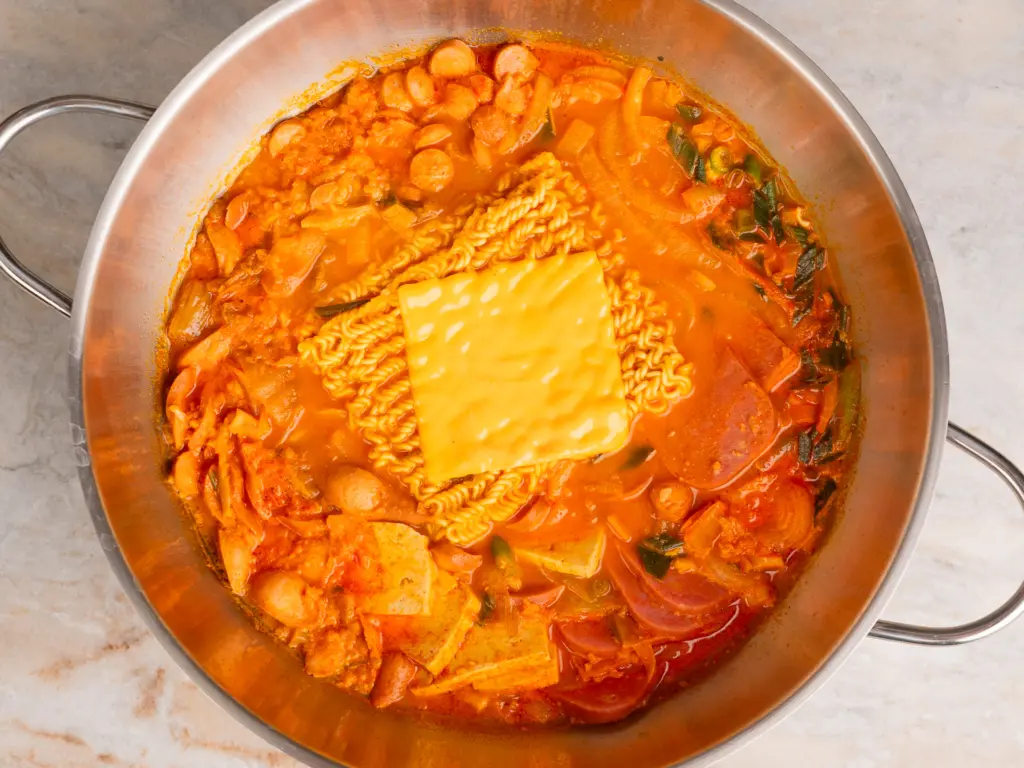
Table of Contents
What is Budae Jjigae? 부대찌개
Korean army stew Budae Jjigae in Korean literally means “army (budae) + stew (jjigae).” It’s called that because this dish was born near a U.S. military base in Uijeongbu, Korea.
After the Korean War, food was scarce in Korea. At that time, the U.S. army bases were stocked with rations like ham and sausages. Koreans, with limited food options, began making stew by adding leftover sausages and ham from the base. That’s how this dish came to be known as military stew. Since the 1970s, instant ramen noodles began to be added, shaping the version we know today. Even now, Uijeongbu is famous for this stew.
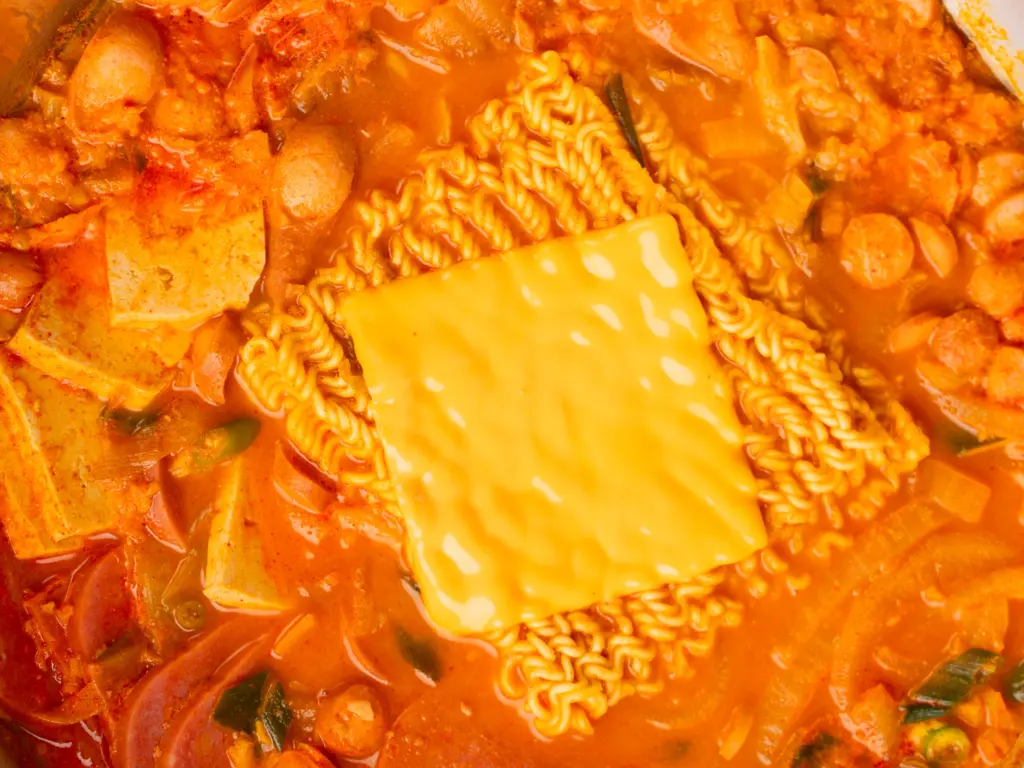
The flavor of army stew is based on spicy gochujang (Korean chili paste) and gochugaru (Korean chili flakes), combined with salty, savory ham and cheese for deep umami. Onion and ketchup add a slight sweetness to balance the taste.
The Difference Between Kimchi Jjigae and Budae Jjigae
The differences between Kimchi Jjigae and Budae Jjigae lie in both their flavors and ingredients.
First of all, Kimchi Jjigae is centered around kimchi. It has a stronger sour taste and is less sweet. It doesn’t include gochujang (Korean chili paste). While you can add ham, it’s more commonly made with pork or canned tuna. Since kimchi is the main ingredient, the meat or other fillings usually take a secondary role.
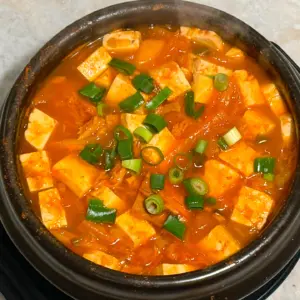
On the other hand, Korean army base stew is all about ham and sausages. With cheese added, it becomes saltier and richer in flavor. Gochujang is used in the broth, which gives it a spicier, deeper taste. Another unique point is the addition of baked beans or ketchup in the seasoning, which adds a touch of sweetness.
Types of Army Stew
There are 2 main styles of Army Stew: the Uijeongbu style and the Songtan style.
Uijeongbu Style
Uijeongbu Budae jjigae has a clearer broth and includes kimchi, tofu, sausages, and ham. It’s lighter in taste compared to the Songtan style, and the umami from the kimchi balances nicely with the other ingredients.

Songtan Style
Songtan Budae jjigae includes cheese and baked beans, with more sausages and ham. The broth is thicker, richer, and has a bolder flavor overall.
Today, I’m making a recipe that combines both kimchi and cheese to create a balanced version that falls somewhere between the Uijeongbu and Songtan styles.
Budae Jjigae Ingredients
Let’s see Korean army stew ingredients.
- Seasoning Sauce: The army stew base is a blend of gochujang (Korean chili paste), doenjang (fermented soybean paste), gochugaru (Korean chili flakes), soy sauce, fish sauce, and ketchup. These ingredients create a spicy, savory, and slightly sweet flavor.
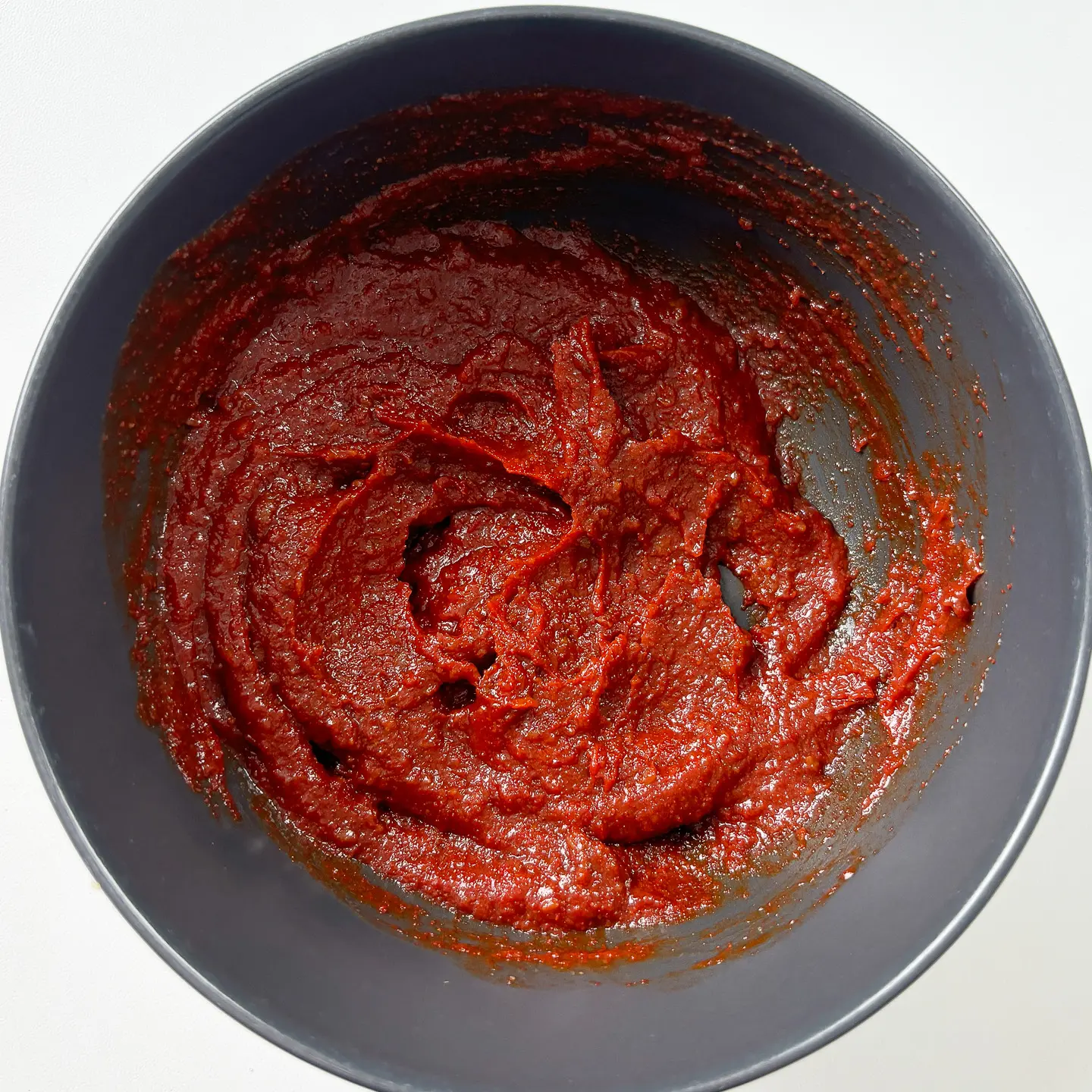
- Broth: The most common budae jjigae soup base is beef bone broth (sagol broth), which gives the soup the rich flavor found at Korean restaurants. If you don’t have beef bone broth, you can use a seafood-based broth, such as anchovy or kelp, for a lighter, cleaner taste.
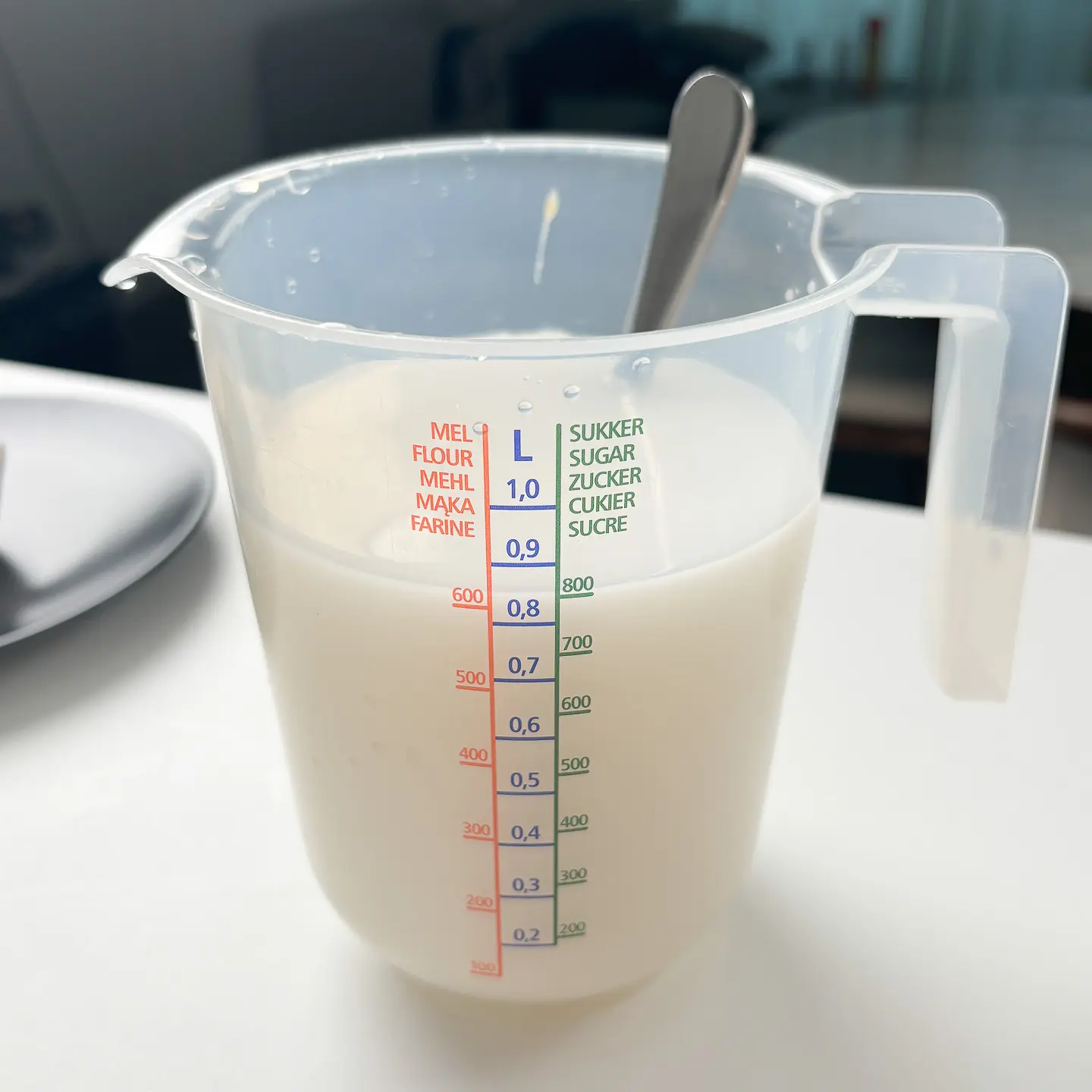
- Green onion, garlic, onion, and kimchi: These add depth and a bit of sharpness to the broth.
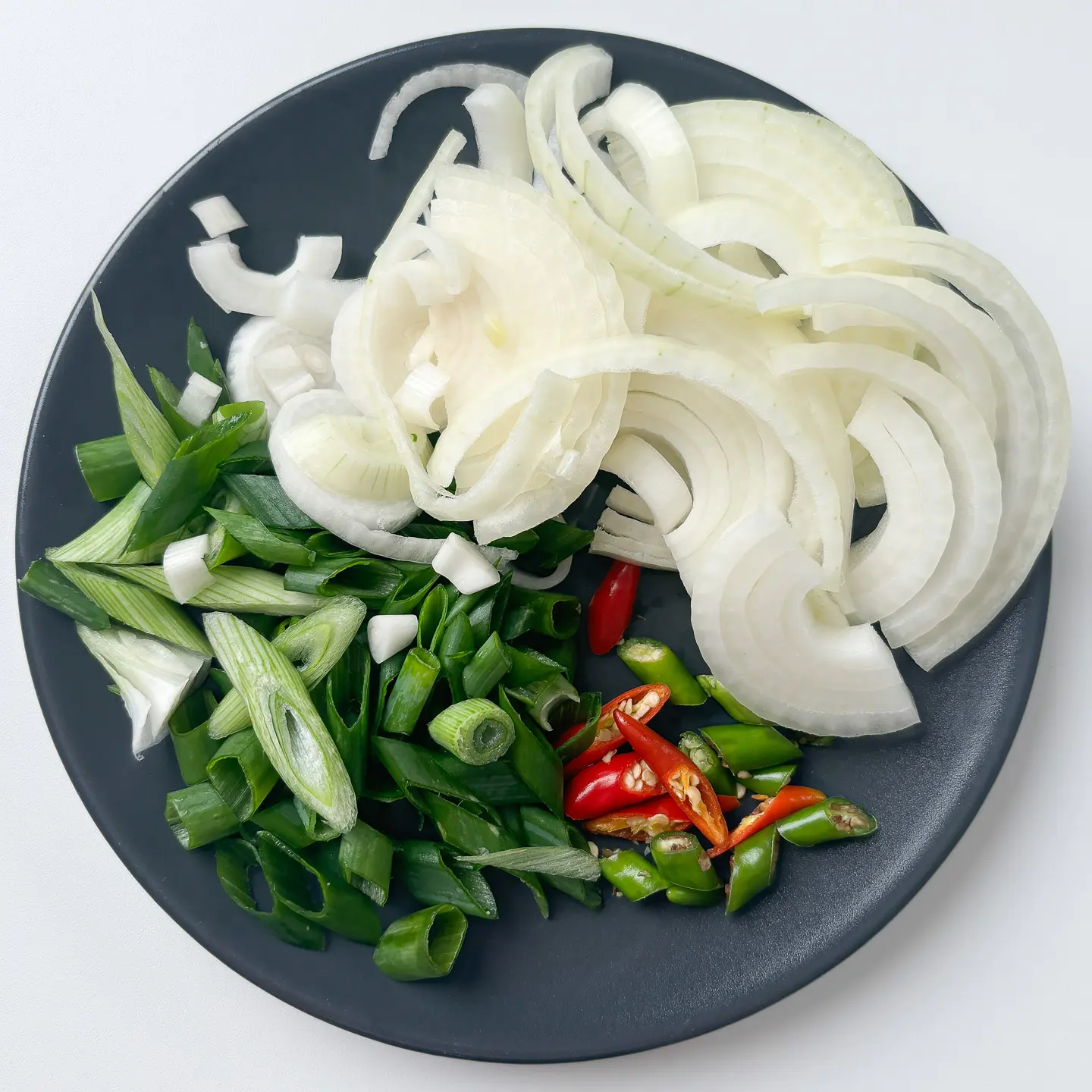
- Ham and Sausages: You’ll need frankfurter-style sausages and canned ham. In Korea, Spam is typically used, but if you’re in Europe and can’t find Spam, luncheon meat works well as a substitute.
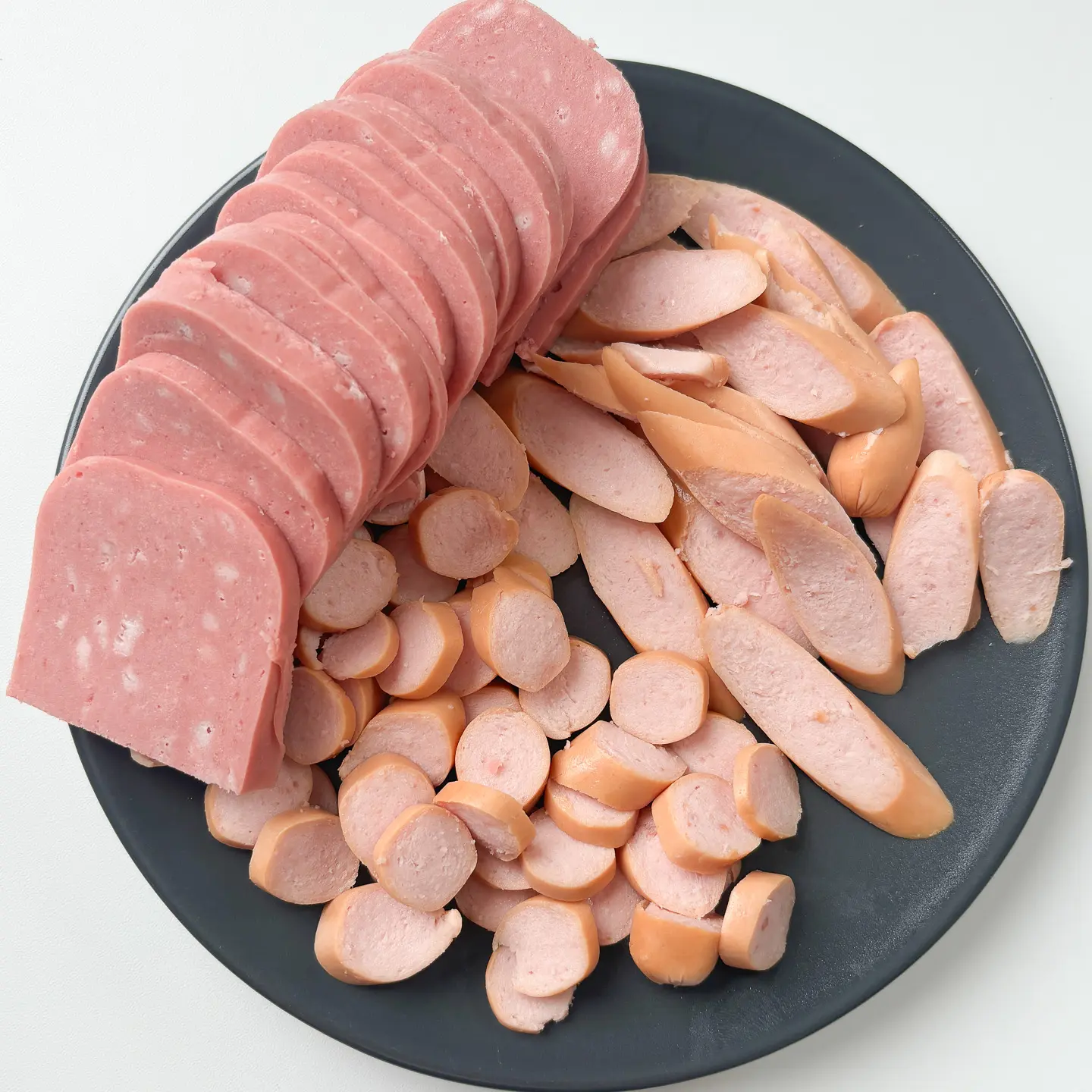
- Cheese, rice cakes (tteok), and ramen noodles: These toppings make the stew even more flavorful. Use a slice of cheddar cheese for a richer and creamier broth. I didn’t have rice cakes today, but if you add sliced garaetteok (rice cakes for tteokguk), they soak up the spicy broth and become deliciously chewy.
- Baked Beans (optional): If you want a thicker, slightly sweeter broth, you can add 2 tablespoons of baked beans. Personally, I prefer a lighter taste, so I left them out.
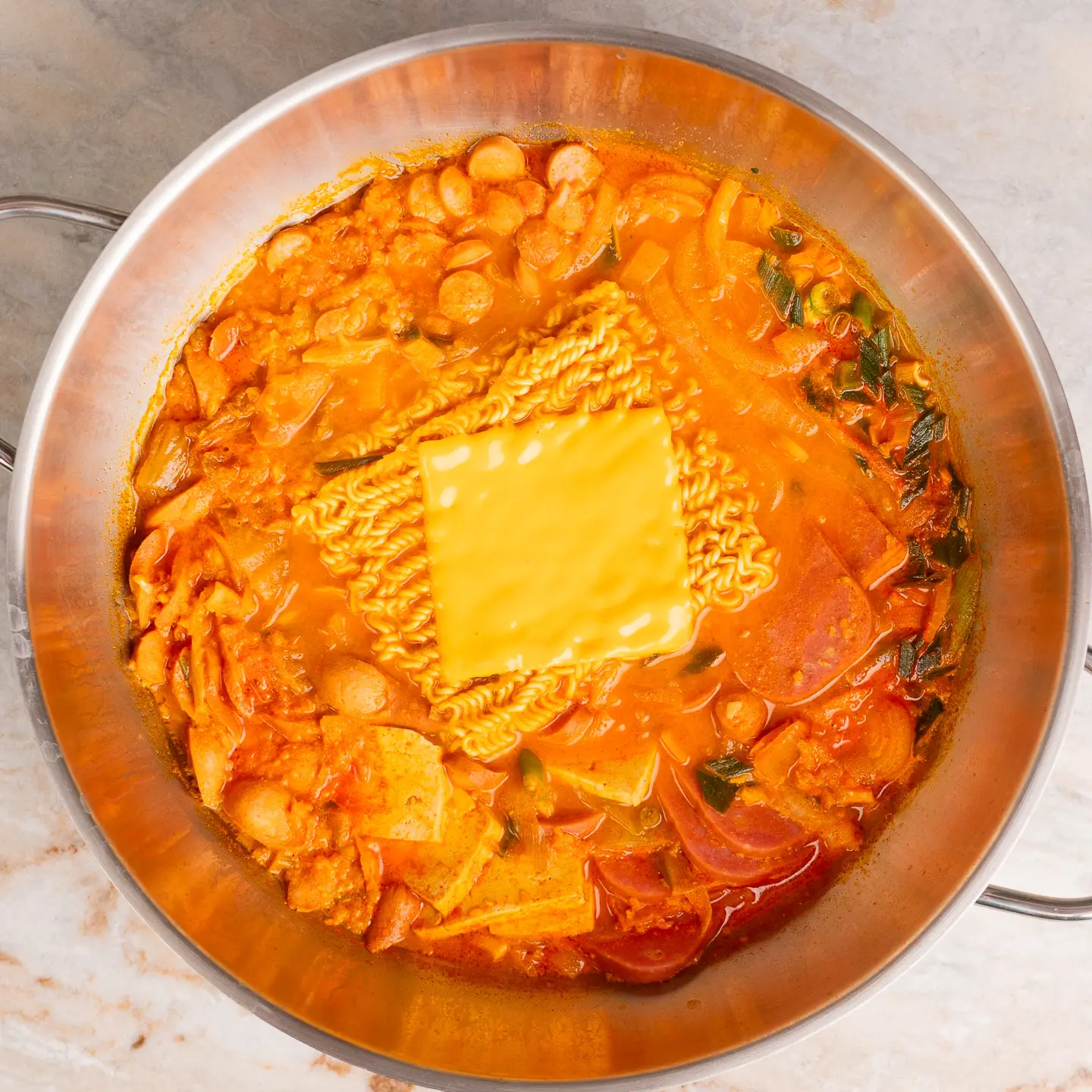
Ingredient Substitutes
- Luncheon meat: Spam offers the most authentic Korean flavor, but it can be difficult to find in Europe. If that’s the case, regular luncheon meat from your local grocery store is a fine substitute.

- Chicken or turkey ham: If you don’t eat pork, you can substitute chicken- or turkey-based luncheon meats and sausages.
- Fish Sauce: If you can’t find Korean fish sauce, Vietnamese fish sauce is a great alternative and works well in this recipe.
- Seafood Broth: Beef bone broth (sagol broth) is hard to find in Europe. In that case, you can use dried anchovies and kelp to make a lighter seafood broth. The taste won’t be exactly the same as restaurant-style, but it’s a common substitute in homemade versions when sagol broth isn’t available.
- Ramen Seasoning Packet: Dashida, a Korean beef stock powder, is a key ingredient for adding a rich umami flavor to budae jjigae. If you don’t have any, you can use about one-third of a ramen seasoning packet as a substitute. It adds a similar depth of flavor.
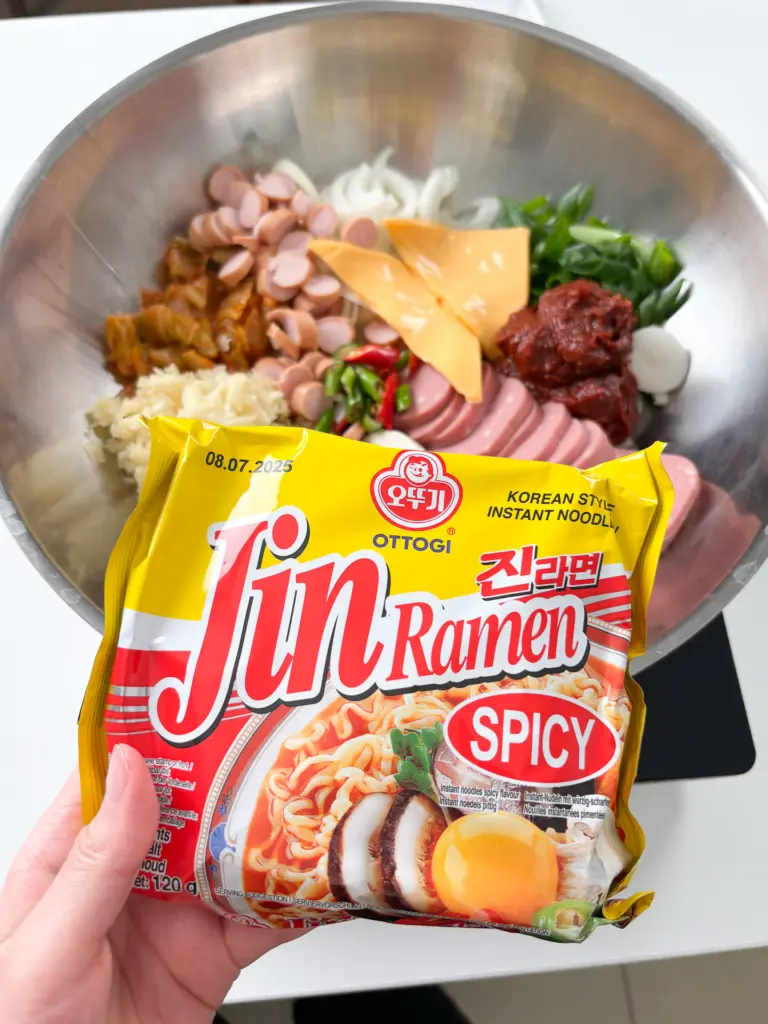
- It’s worth it to have a pack of Dashida in your pantry because it enhances soups, stews, tteokbokki, and many other Korean dishes.
Budae Jjigae Recipe
Budae jjigae is a super simple one-pot recipe — just throw everything into a pot and let it boil!
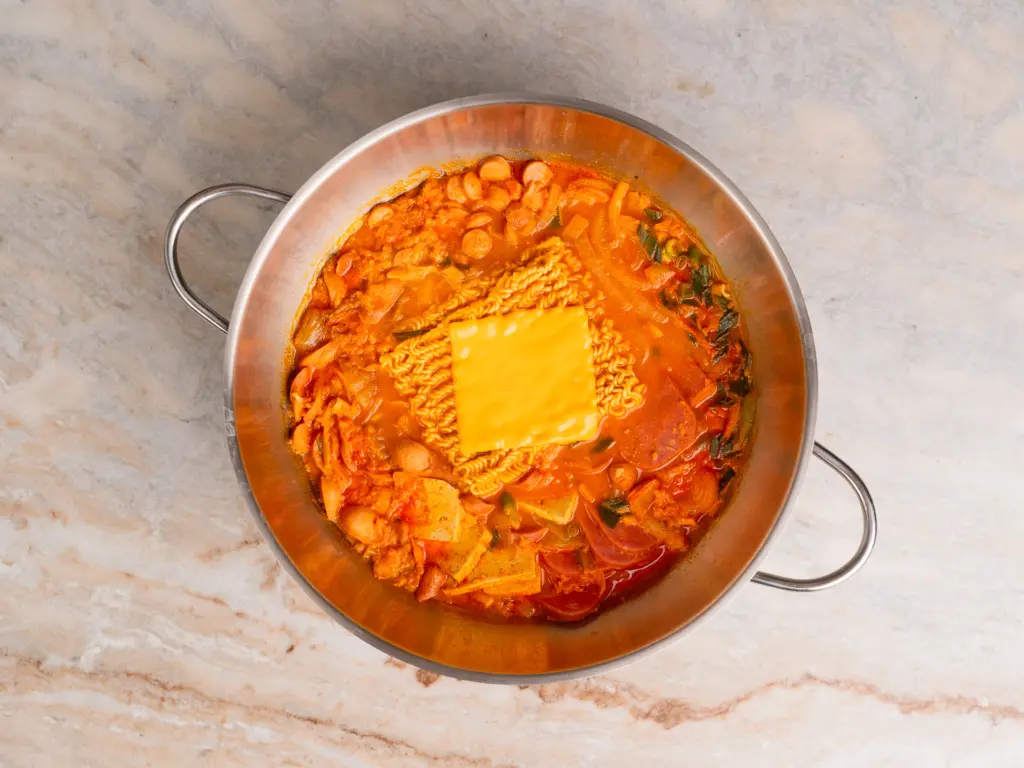
- Layer the ingredients: Begin by neatly arranging your vegetables (such as onions and scallions), tofu, sausages, ham, rice cakes, and ramen noodles in a large pot.
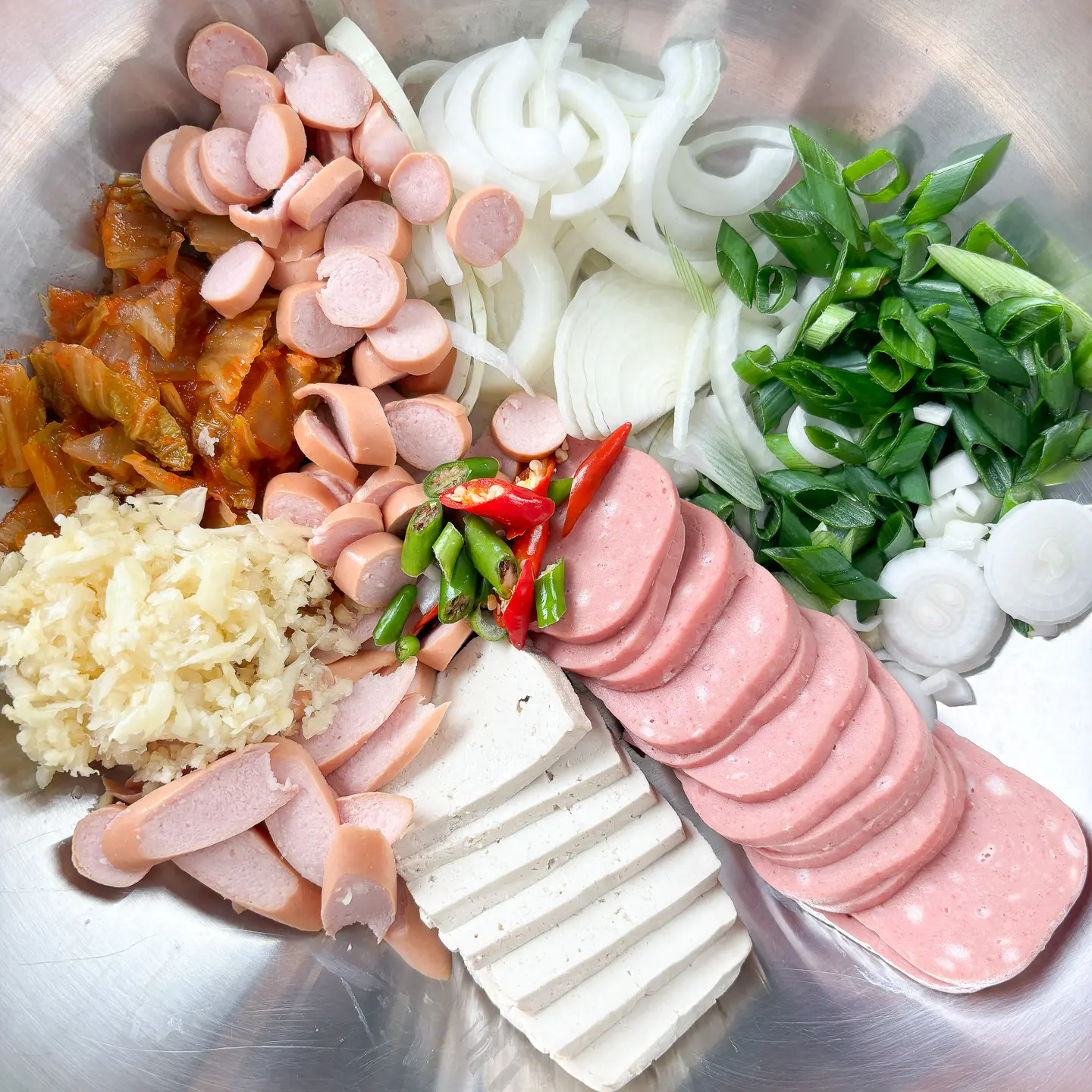
- Add the sauce: In a small bowl, mix together the sauce ingredients (gochujang, doenjang, soy sauce, fish sauce, ketchup, etc.) ahead of time, then pour the mixture over the ingredients in the pot.
- Add garlic and broth: Add minced garlic generously, then pour in the beef bone broth (or substitute broth) until everything is just covered.
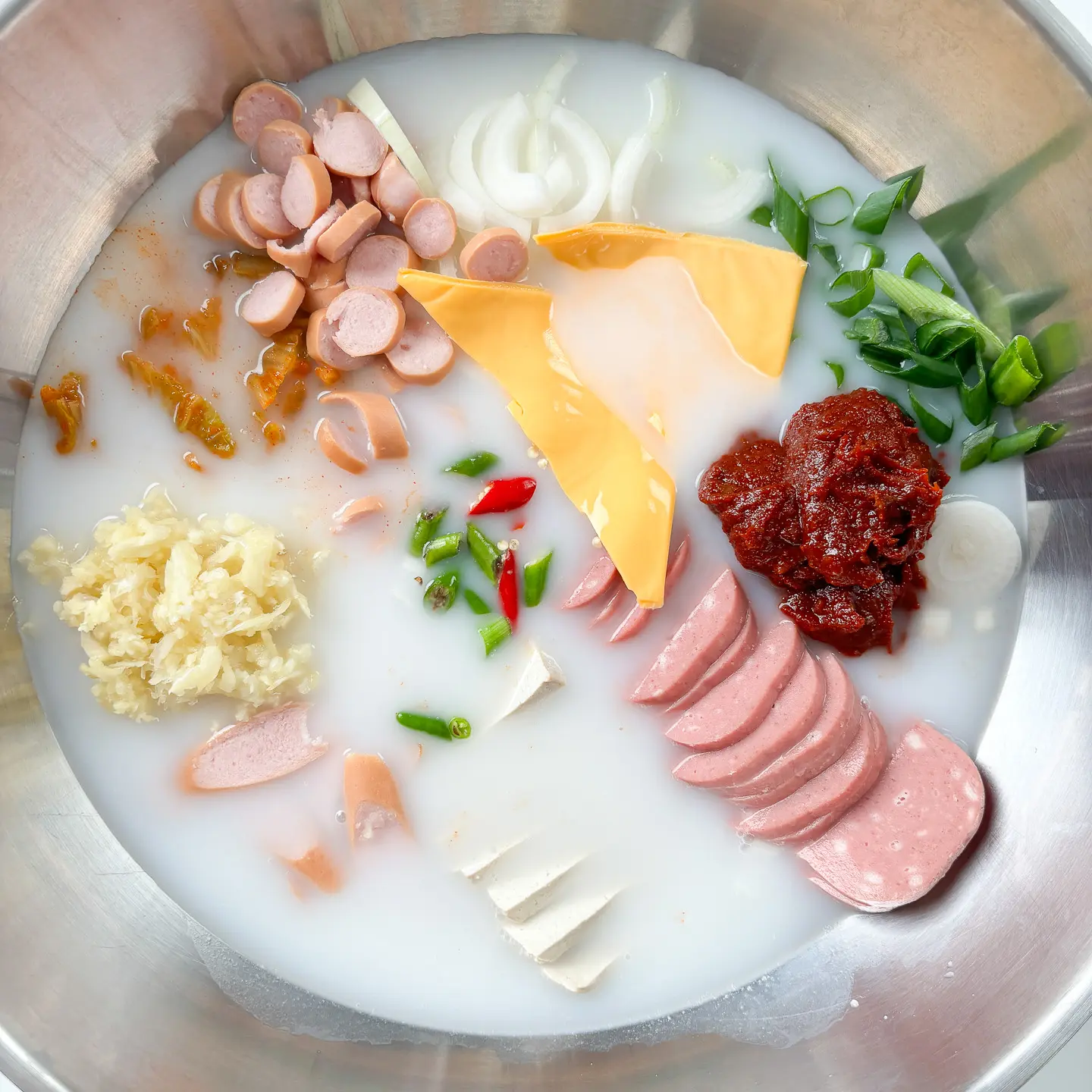
- Bring to a boil: Turn the heat up high. Once it starts boiling, reduce the heat to medium and let it simmer until the flavors have soaked into the broth.
- Add rice cakes and ramen: Add the rice cakes and ramen noodles at the end and cook until the noodles are fully cooked.
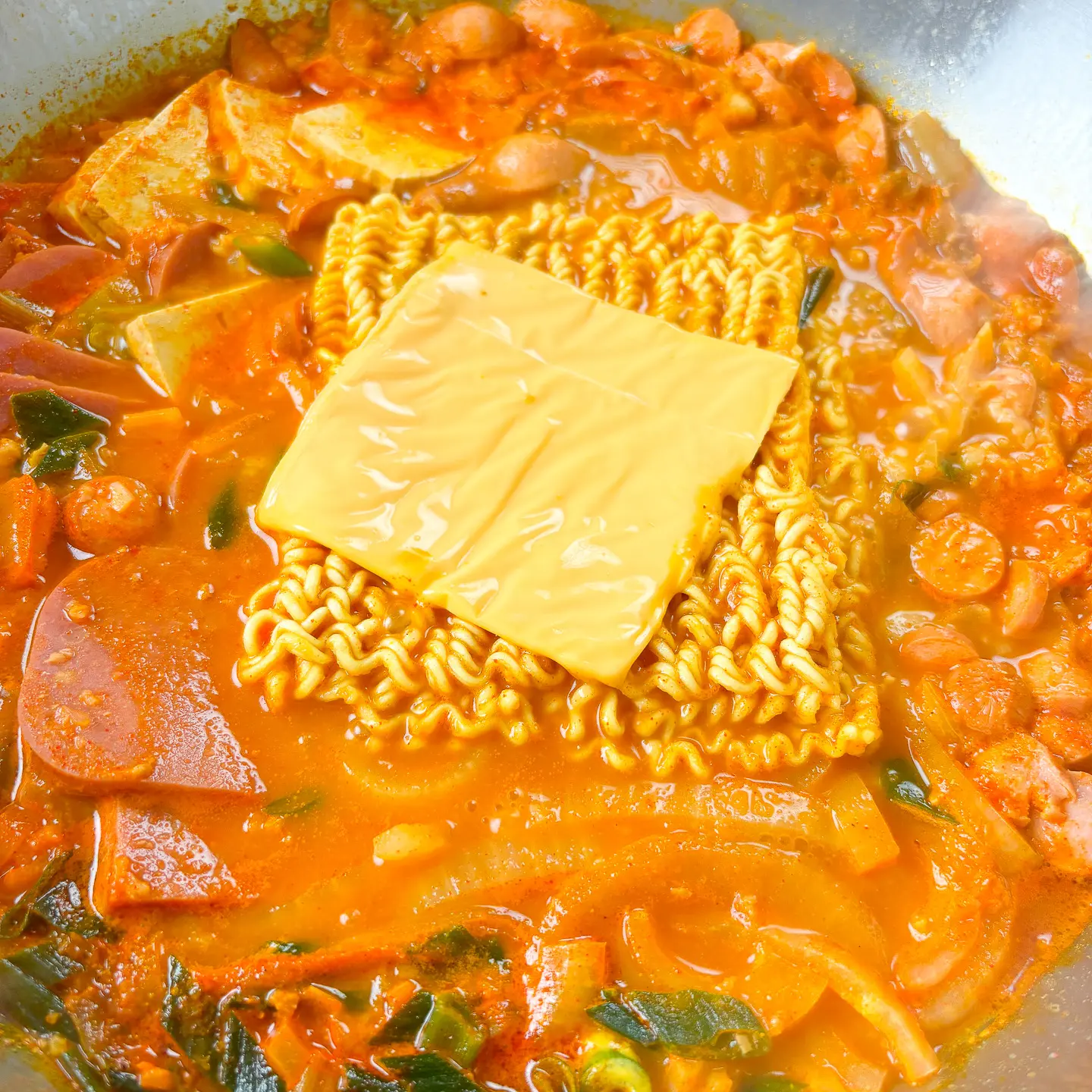
Cooking Tips
- Lots of Garlic: Use lots of garlic! Don’t hold back on the garlic! The more you add, the deeper and richer the broth’s flavor becomes.
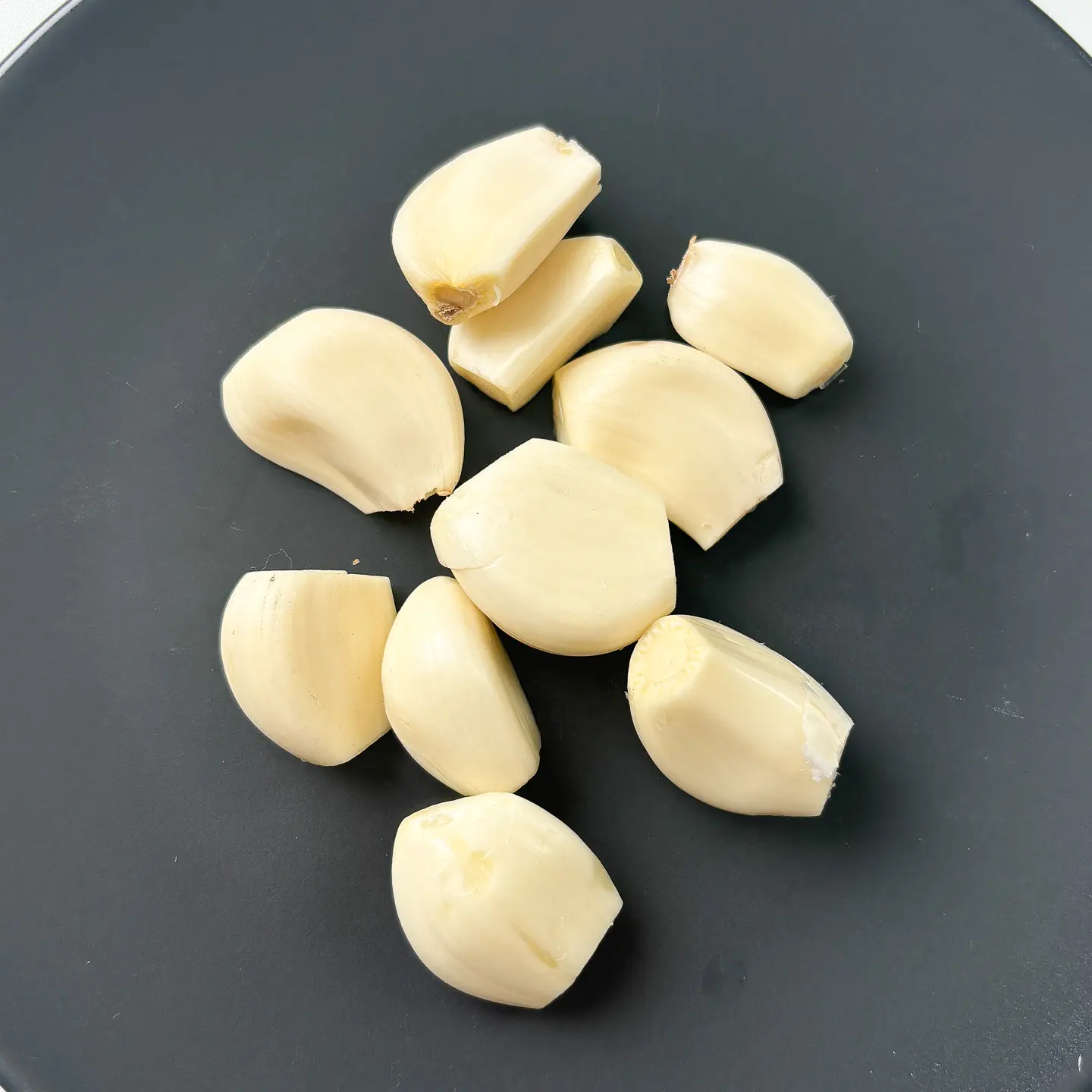
- Thinly sliced sausage: Slice your sausages and ham thinly. This allows the broth to soak in better, making each bite more flavorful.
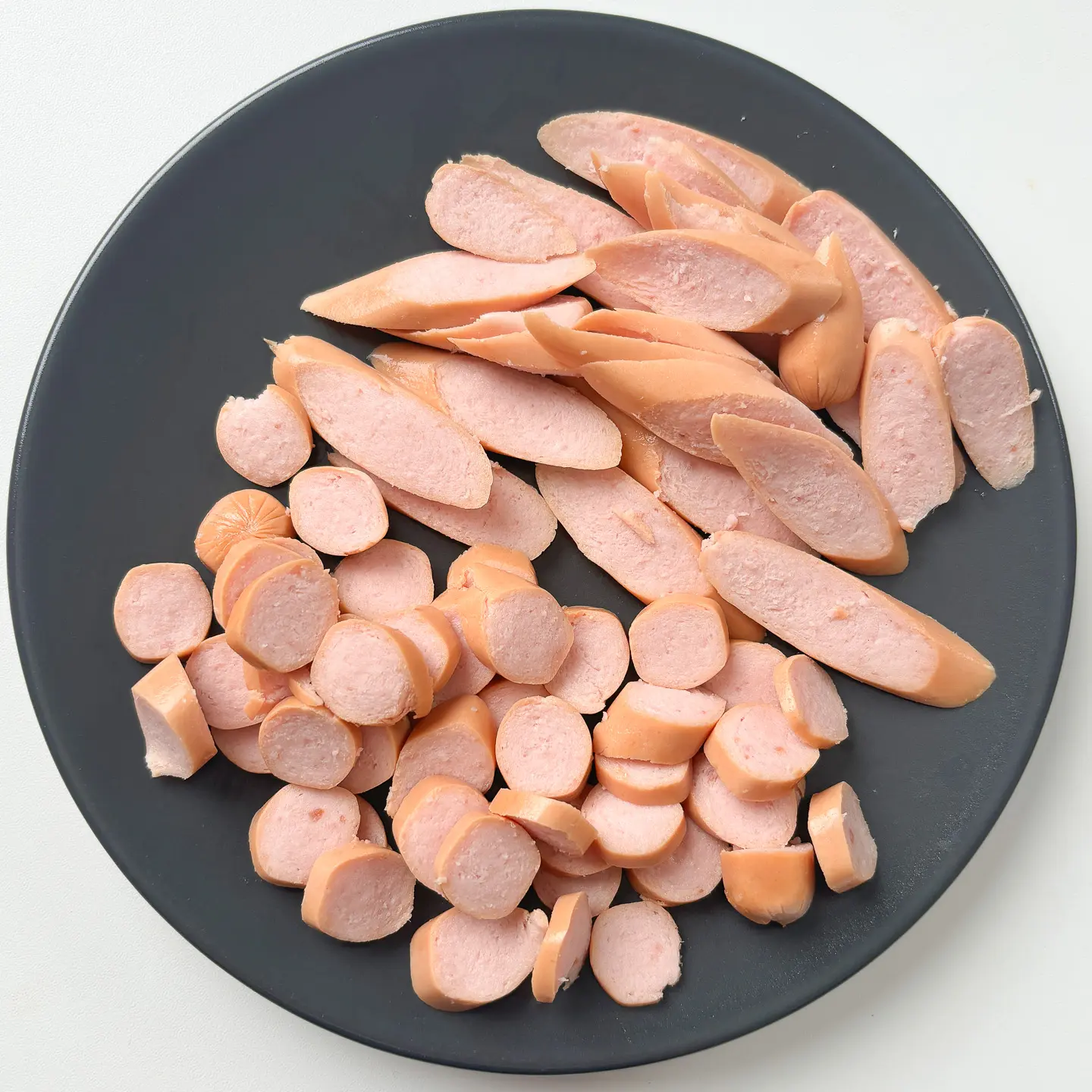
- Kimchi brine: When adding kimchi to a dish, pour in some of the kimchi juice, too. This adds a slight tanginess that enhances the umami flavor of the stew.
- Dashida (Korean beef stock powder): For a restaurant-quality flavor, Dashida is essential. Without it, your stew might taste incomplete. You can find substitute suggestions in the “Ingredient Alternatives” section above.
How to Eat Army Stew
Like many Korean hot pot dishes, budae jjigae is usually served bubbling on a portable gas burner at the table. If you don’t have a portable burner at home, though, you can simply cook everything in the kitchen and bring the pot to the table.
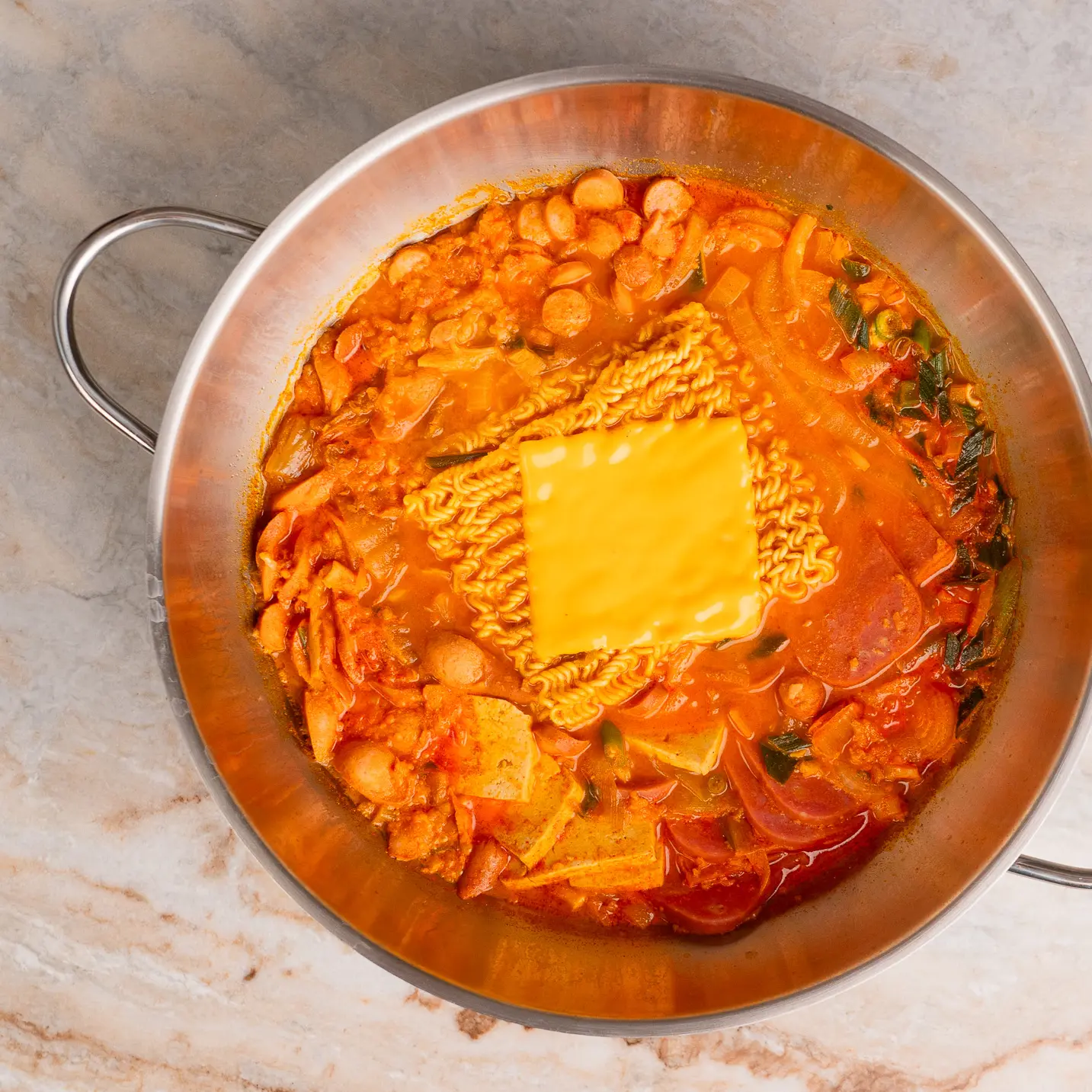
This isn’t a single-serving dish; it’s meant to be shared by two to four people. The recipe I’m sharing today is perfect for two people. Enjoy it as a hearty lunch or dinner with coworkers, friends, or family—or as a shared dish over drinks.
Army stew is always eaten with rice. Scoop out the ham and sausage, ladle the spicy broth, and enjoy it with rice. The ramen noodles in the stew are best eaten before they get too soggy, so make sure to pull them out early and enjoy them while they’re still chewy.
Get Ingredients Here
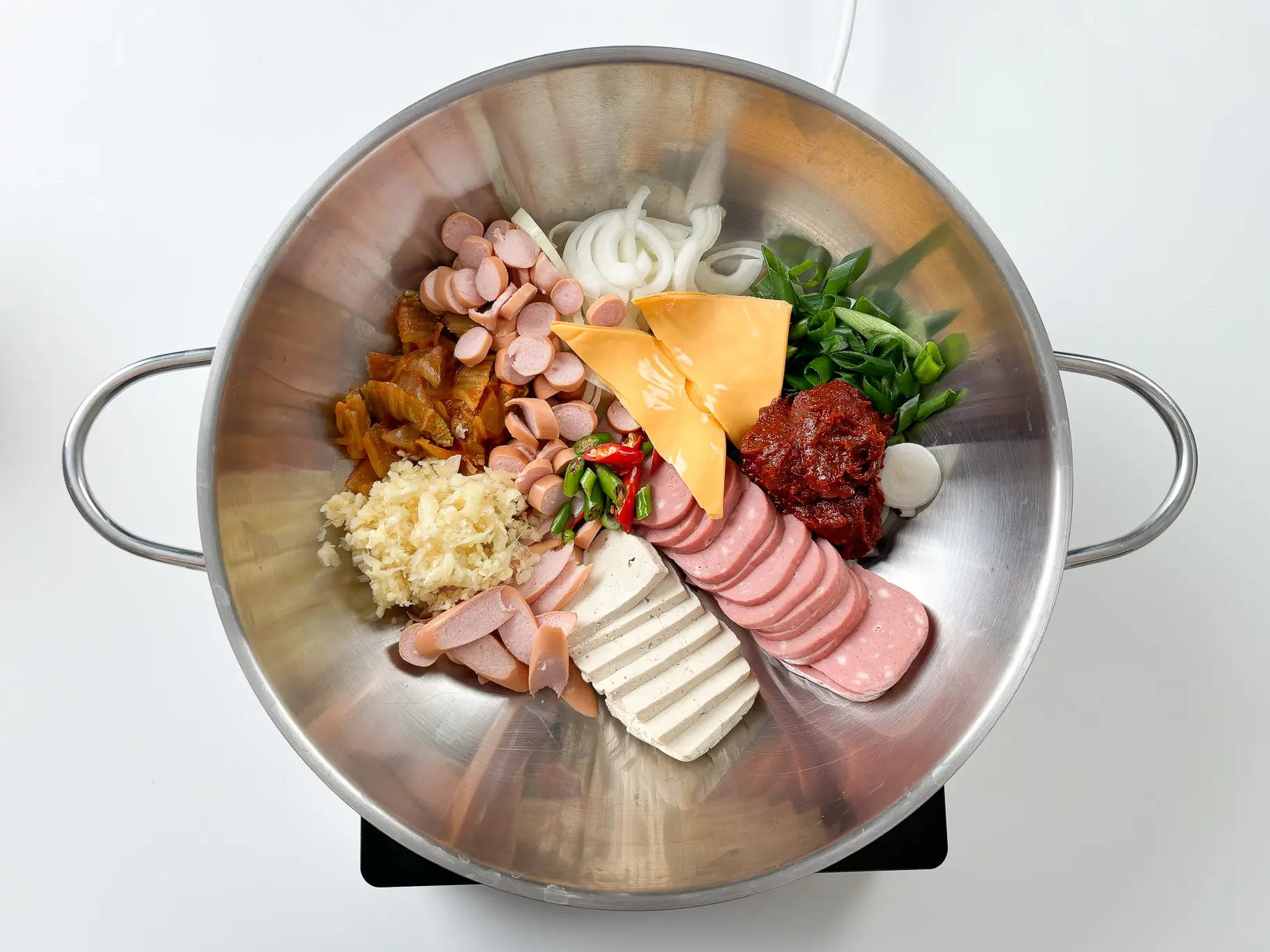
- Bone broth (sagol): US
- Bone broth coin: US
- Rice Cooker: US
- Korean Dashida: US
- Gochujang (Korean red chili paste): US
Disclosure: Blonde Kimchi is part of the Amazon Services LLC Associates Program, an affiliate advertising program that allows websites to earn advertising fees by linking to Amazon.com and promoting products.
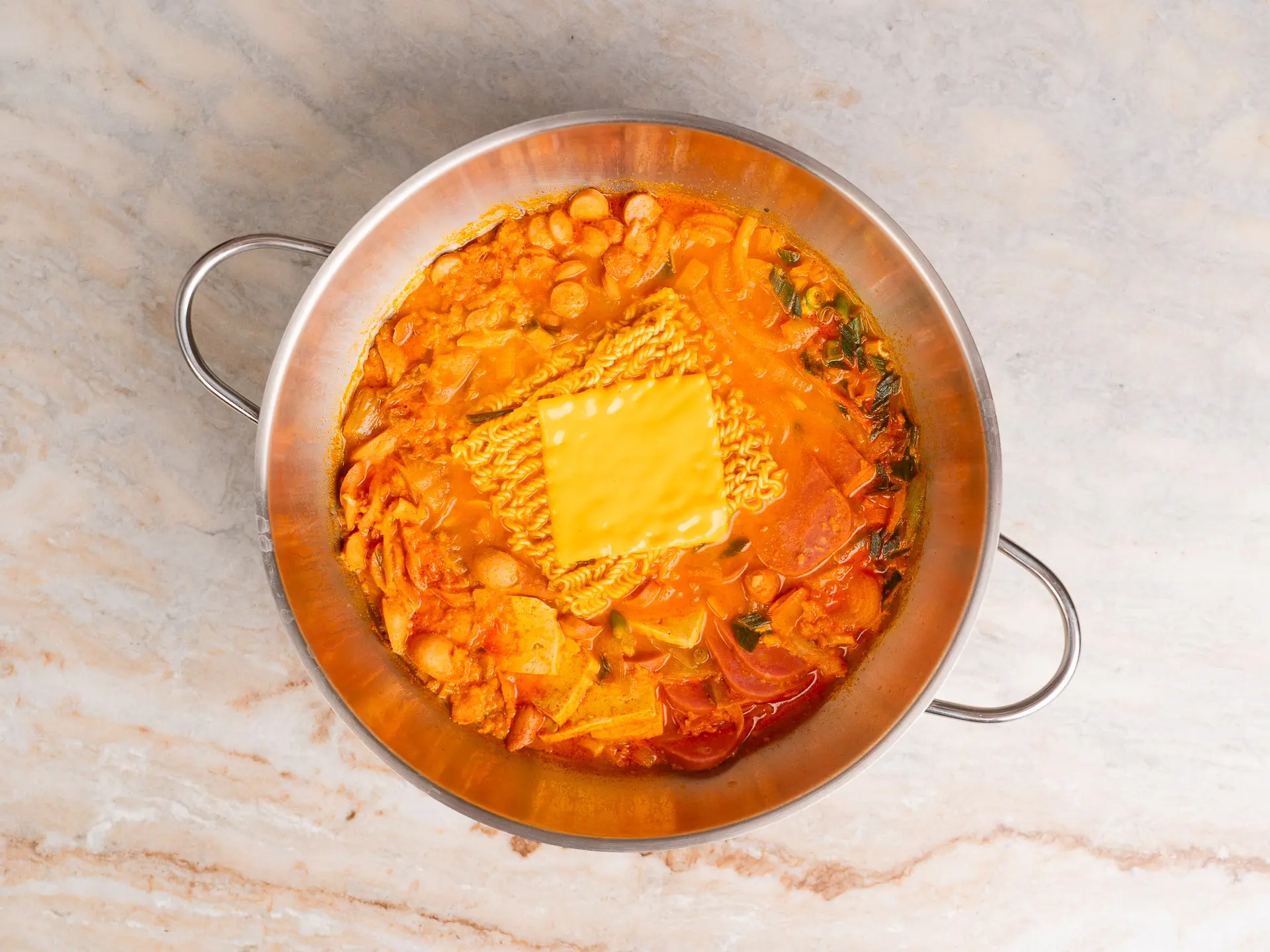
Authentic Budae Jjigae, Korean Army Stew
Ingredients
- 3 tbsp minced garlic
- 1 pack instant ramen noodles
- 100 g tofu
- 1 can spam or luncheon meat
- 60 g kimchi
- 2 tbsp kimchi juice
- 4 frank sausages
- 1/2 onion
- 1 stalk green onion
- 1~2 slices cheese
- 1 packet beef bone broth
- 900 ml water
Equipment
- 1 jeongol pot (Shallow wide pot)
- 1 Cutting board & knife
- 1 Tongs
- 1 ladle
- 1 kitchen scissors
Method
- Slice the sausages into both round and diagonal shapes, and cut the spam into pieces.4 frank sausages, 1 can spam or luncheon meat
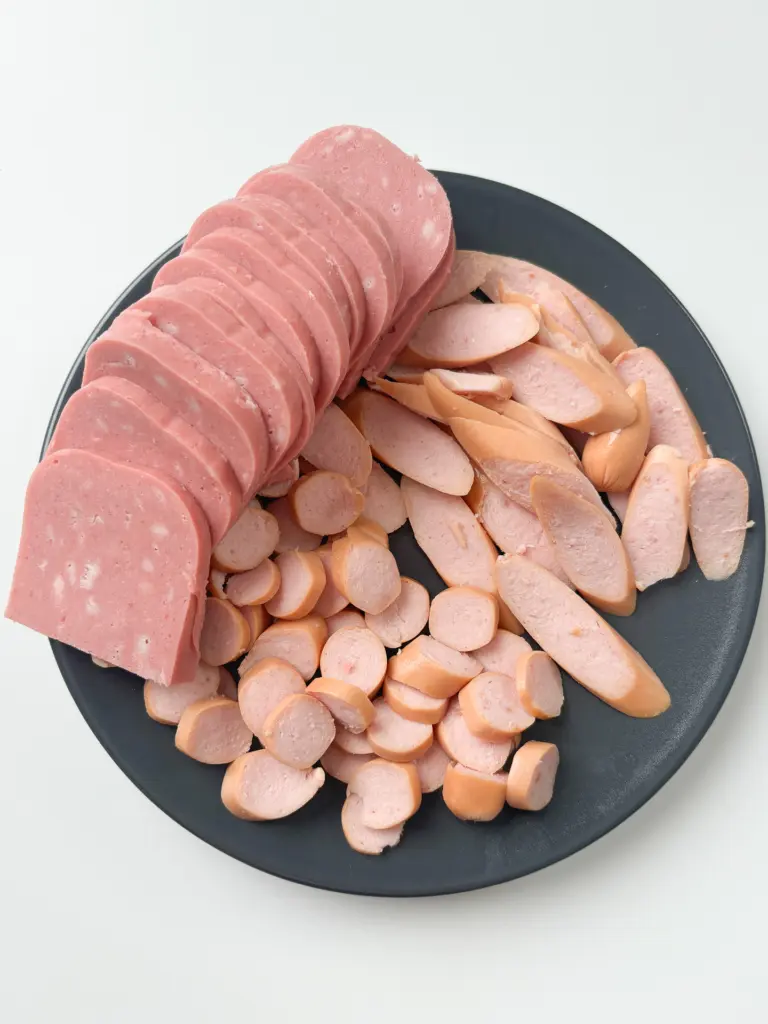
- Thinly slice the onion and diagonally cut the green onion. If you want, you can add peppers.1/2 onion, 1 stalk green onion
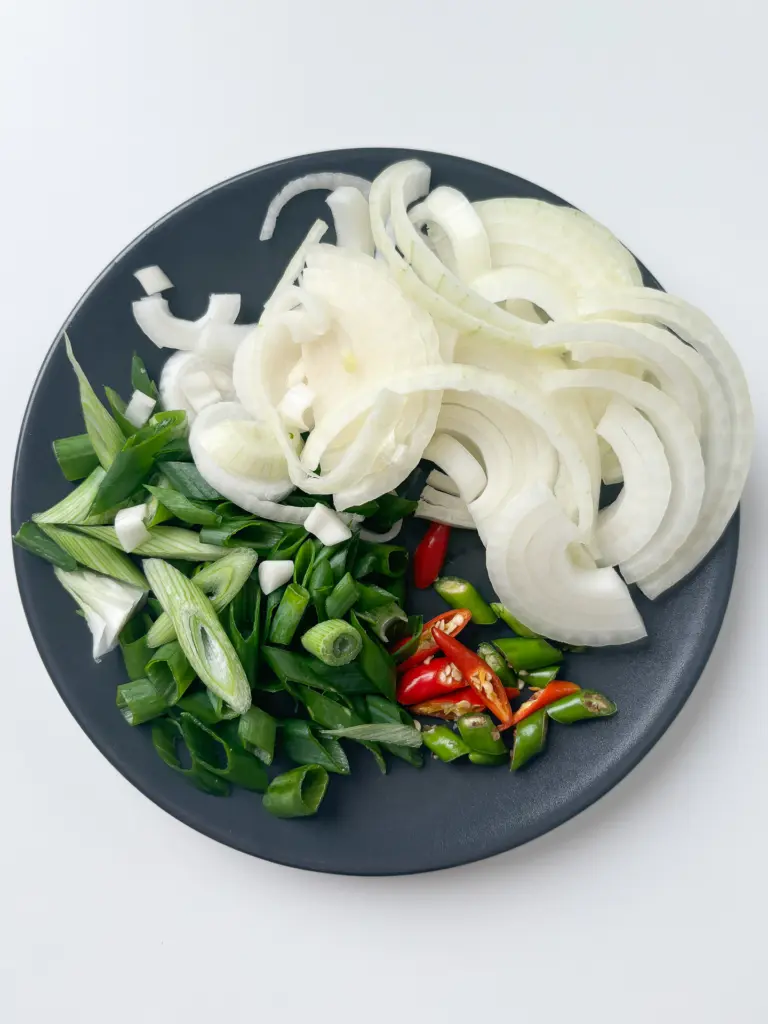
- Cut the tofu into cubes similar in size to the luncheon meat (spam).100 g tofu
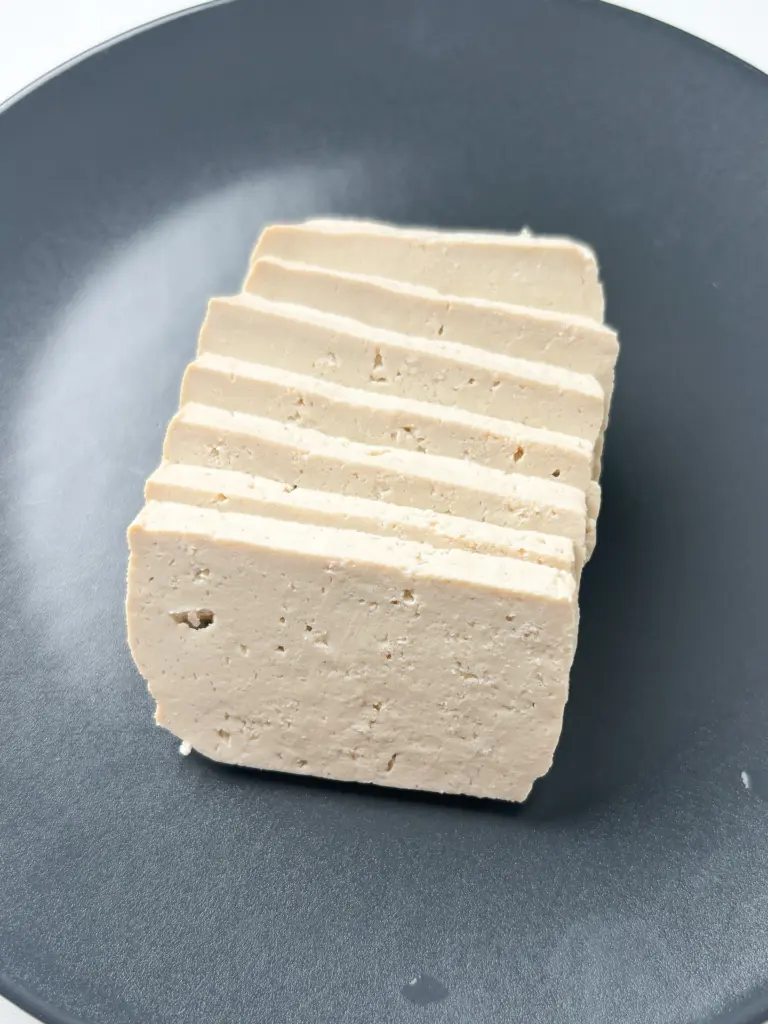
- Finely cut the kimchi using kitchen scissors and reserve 2 tbsp of kimchi juice.60 g kimchi, 2 tbsp kimchi juice
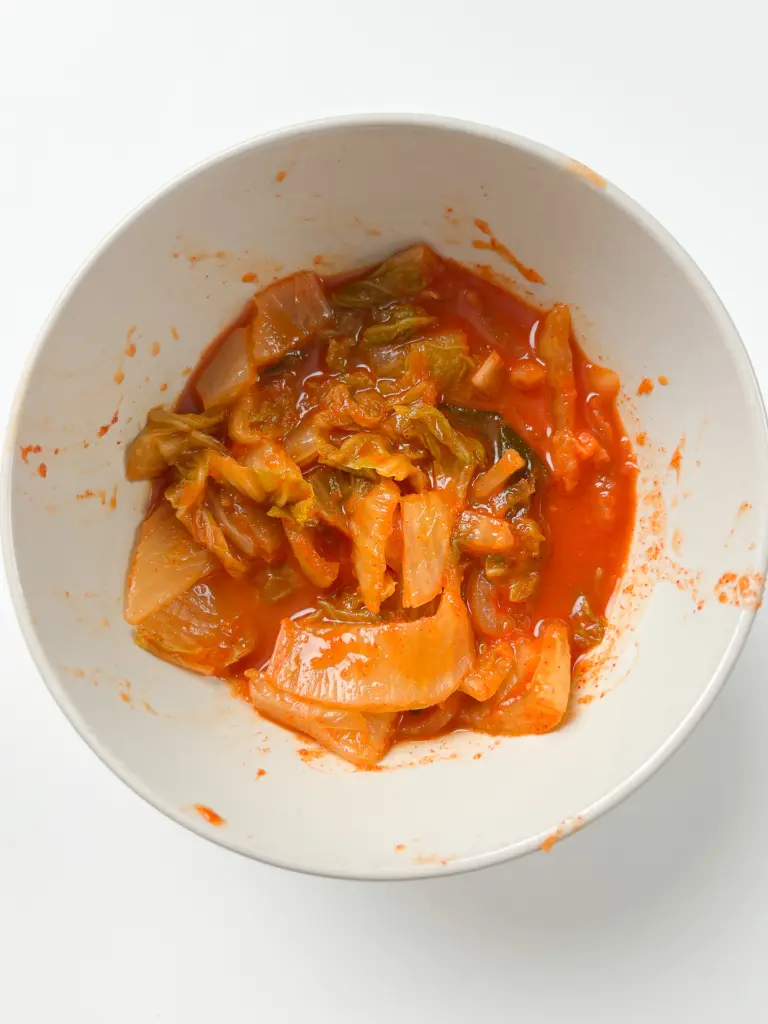
- In a small bowl, mix all the seasoning paste ingredients.1 tbsp gochujang, 1/2 tbsp doenjang, 1 tbsp gochugaru, 1 tbsp soy sauce, 1 tbsp anchovy fish sauce, 0.7 tbsp Korean dashida, 2 tbsp ketchup
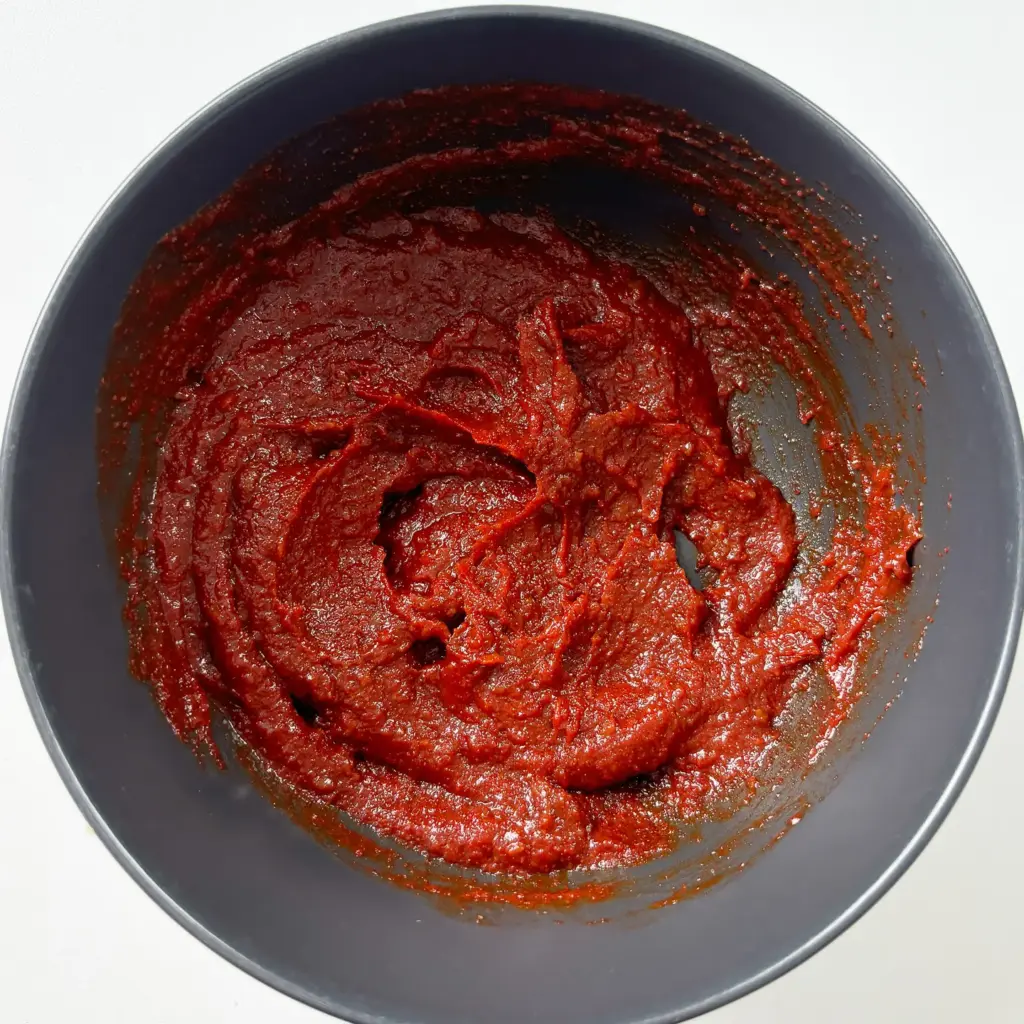
- In another container, mix the concentrated beef bone stock with 900ml of water to make the broth.1 packet beef bone broth, 900 ml water
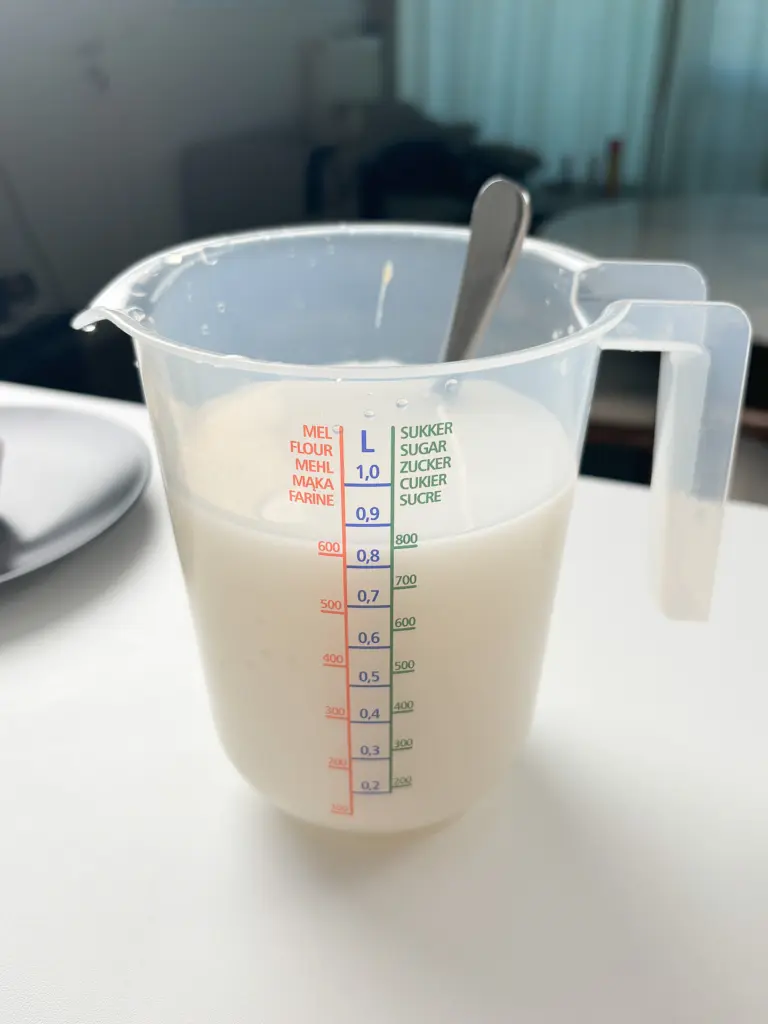
- Use a shallow, wide hot pot (deeper than a frying pan).
- Neatly arrange the green onion, onion, Spam, sausages, tofu, chopped kimchi, kimchi juice, and 1 slice of cheese in the pan.1~2 slices cheese
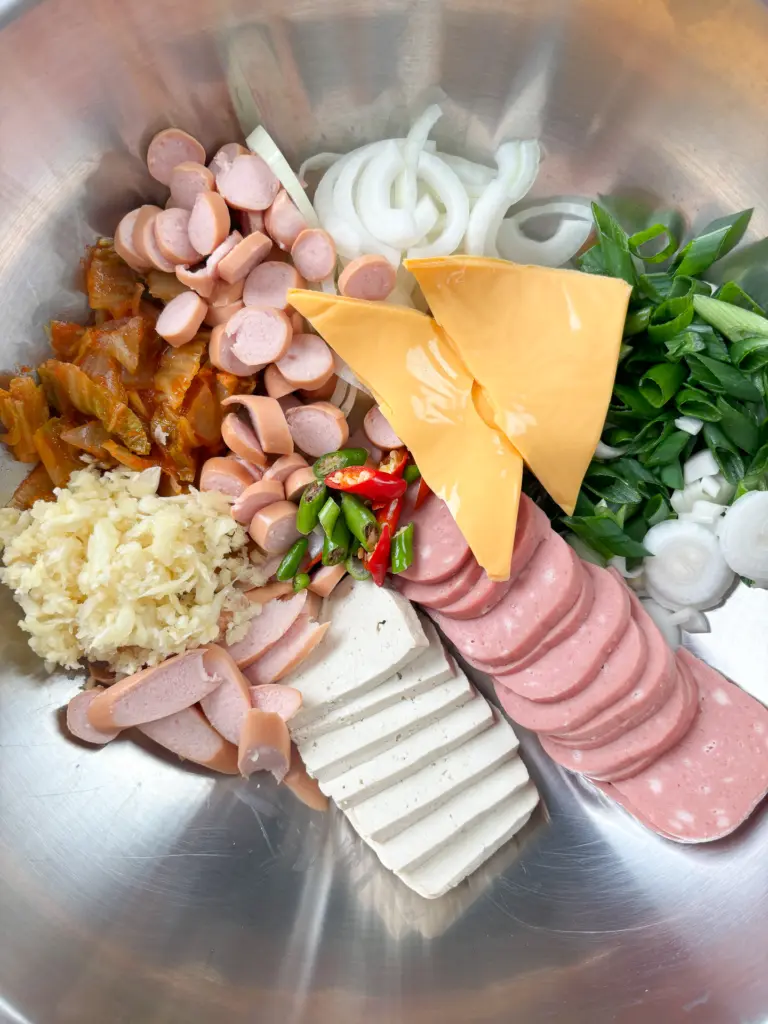
- Add the minced garlic and prepared seasoning paste on top.3 tbsp minced garlic
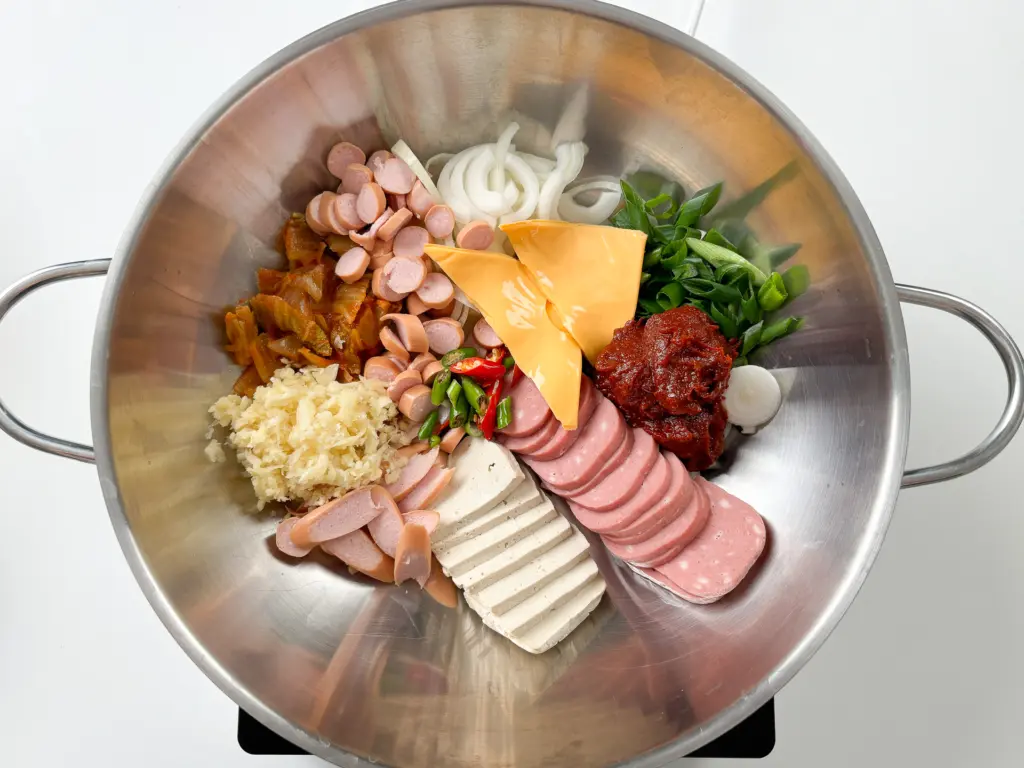
- Pour the beef bone broth over everything.
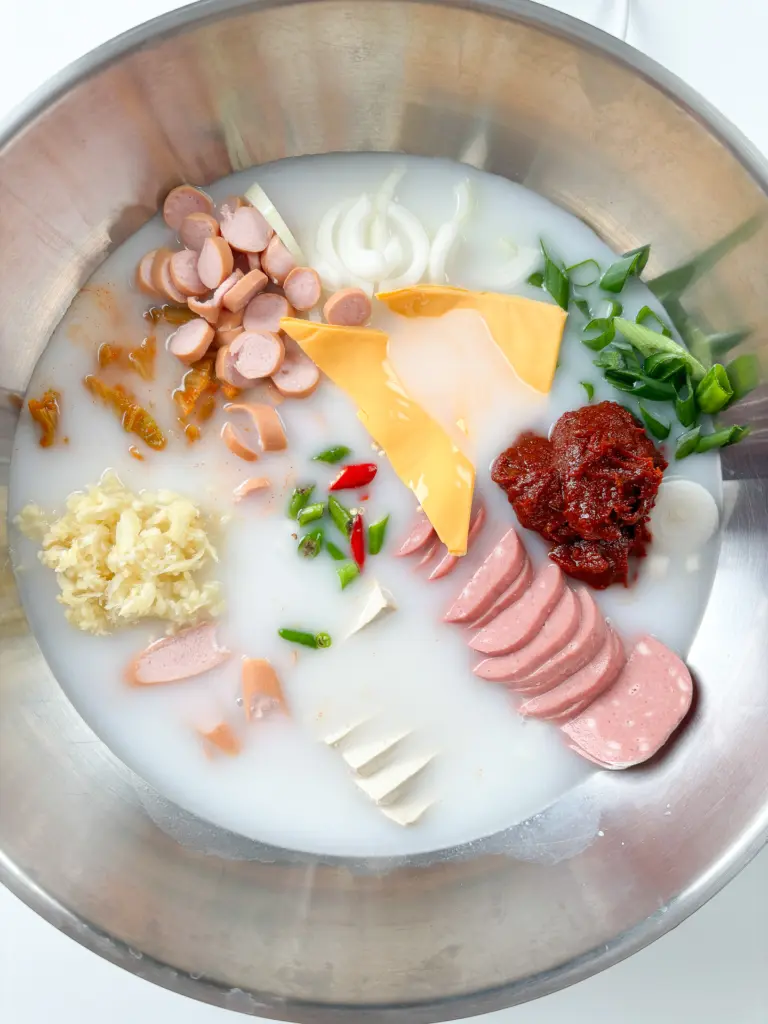
- Bring it to a boil over high heat. Once boiling, reduce to medium heat and simmer for 10 minutes.
- Add the ramen noodles and cook until noodles are done.1 pack instant ramen noodles

- If the broth reduces too much and becomes salty, add 50–100ml of extra water depending on your preference.

- For a richer, creamier taste, add another slice of cheese like I do! (2 slices in total)
- Jal meokgetseumnida! 잘 먹겠습니다!
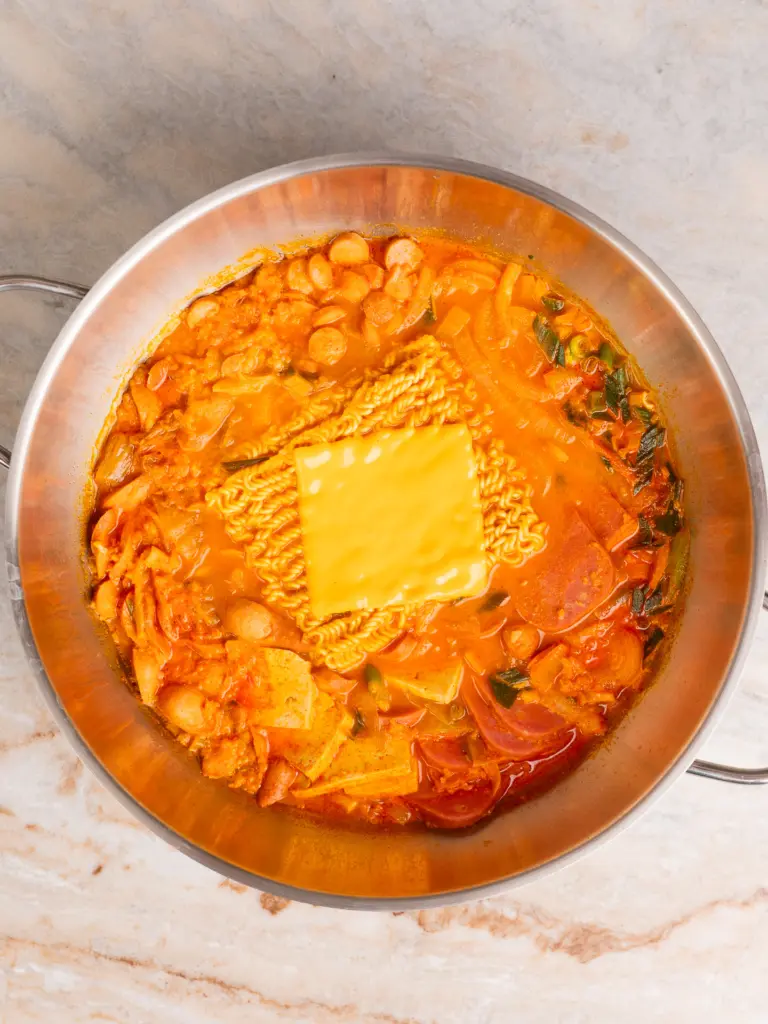
- Scoop up some ham and tofu with the broth and enjoy. Make sure to eat the ramen noodles before they get too soggy. And don’t forget to enjoy it with rice!

Nutrition
Nutritional information is an estimate. For personalized advice, consult a registered nutritionist.
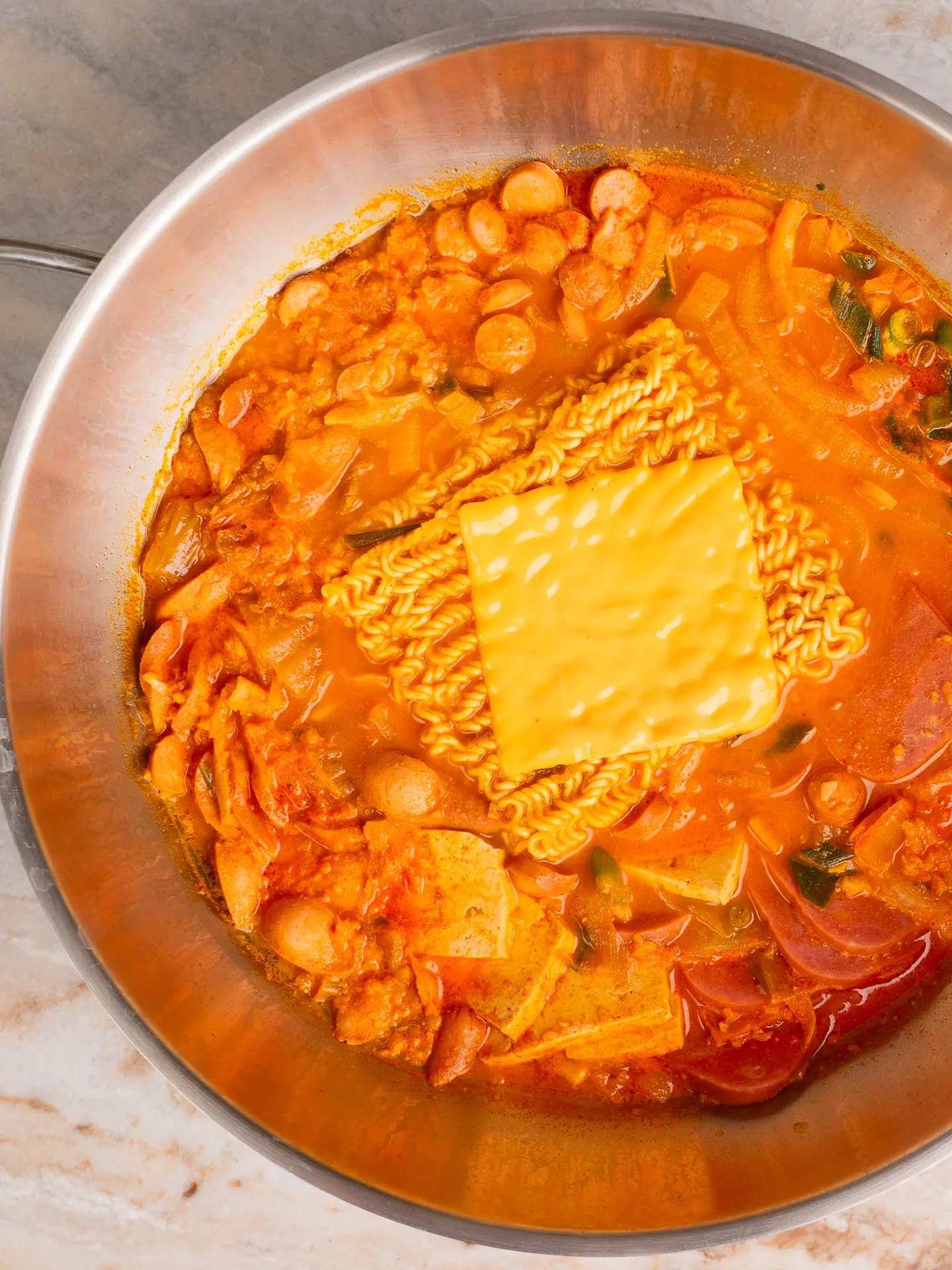

Tastes just like the real thing from a Korean restaurant, thank you!